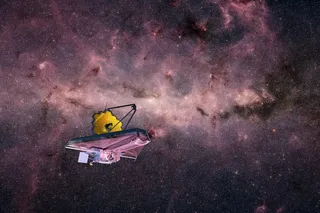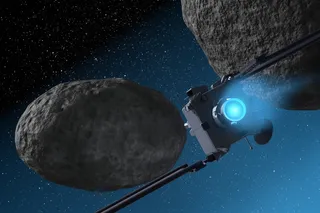Serious astronomical research generally requires a remote mountaintop observatory, but you probably already own a surprisingly effective outpost for studying the universe: your car. There is much you can learn simply by looking and listening as you drive. Some examples:
1. When it’s raining or snowing, notice that the flakes or drops hitting the windshield seem to come from a single spot ahead of you. Step on the gas, and that radiating point descends nearly to eye level. Hit the brakes, and it rises. Your movement affects the apparent position of objects around you, an effect known as aberration. In 1728 English astronomer James Bradley showed how this phenomenon influences starlight too. Like precipitation, stars appear in false places in the sky—in this case, because of Earth’s motion around the sun at 67,000 miles per hour. Each star’s apparent position can be as much as 1/180 of a degree from its true location.
2. The next time an emergency vehicle passes, listen for the Doppler shift. While the siren is moving toward you, sound waves are compressed to a higher pitch. As it moves away the waves are stretched, causing the siren’s wail to deepen. Light makes the same shift, growing bluer on approach and redder on departure. This dance of color allows astronomers to track down otherwise unseen planets, which yank their parent stars back and forth as they orbit. A related stretching and reddening of light seen in nearly every galaxy indicates that the whole universe is expanding.
3. Feel how the car gets warmer as you drive, even if the heater is off. One reason is that each adult passenger emits about as much energy as a 100-watt bulb. Another is that daylight streams into the car, but only some of it reflects back out. The rest is absorbed by items within the car and translated into infrared rays, or heat. Atoms in the windows naturally vibrate at the same frequency as waves of infrared energy, forming a barrier that prevents the heat from escaping. Earth’s atmosphere behaves in the same way, keeping the planet’s average temperature at 59 degrees Fahrenheit rather than the chilly zero degrees it would be if our world were airless.
4. If you roll down the windows, watch how any loose papers inside are sucked out. The air outside is moving rapidly relative to the car, and the brilliant Swiss mathematician Daniel Bernoulli reported in 1738 that a speedy gas or liquid always results in reduced pressure. Bernoulli’s principle helps keep the wings of a jet plane aloft. It also allows the space shuttle to glide back to Earth for a runway landing. Without Bernoulli’s principle at work, the shuttle would drop like a stone, in the manner of the old Apollo capsules.
5. Look for the moon in the sky. If you see it in the morning, it is always lit on the left side; if you see it in the evening, it is always lit on the right. The morning half-lit moon—technically called, confusingly, the quarter moon—is right in front of our planet as we orbit the sun. Face it, and you are looking forward as Earth whizzes through space. Conversely, the evening quarter moon lies to Earth’s rear.
6. Switch on the radio and pay attention to the reception. FM stations tend to fade near hills, while AM signals are much steadier. The reason: Diffraction, the ability of waves to bend around obstacles. Thousand-foot-long AM radio waves diffract far more readily than 10-foot-long FM waves. Truly giant waves, such as water waves rolling across the ocean, can bend around an entire island and magically reappear behind it. Diffraction also causes unavoidable blurriness in telescopes, as light waves bend around the secondary mirror used to direct and focus the image.
7. As you pull into the parking lot, glance down. See any puddles with colorful oily swirls? Thin layers of oil on the puddles create secondary reflections off the water, causing certain light wavelengths, or colors, either to reinforce or to cancel out others. This process is known as interference. Astronomers exploit it to combine light or radio waves collected by widely separated telescopes so that they act as a single huge instrument, as large as the distance between the two of them.
Who knew your daily commute could be so cosmic?
What’s up in the September sky
September 1 - Venus and Jupiter meet closely in the western twilight; both outshine every star.
September 6 - The crescent moon joins Jupiter and Venus. The night’s three brightest objects form a triangle low in the sky just after sunset.
September 15 - Mars doubles in brightness this month. It rises by 10 p.m. and is conspicuous by midnight.
September 22 - The equinox brings in autumn at 6:23 p.m. EDT as the sun crosses into the southern sky.
Early and late September - These moonless periods are ideal for seeing the Milky Way, now at its best of the year.
All month - Darkness increases at the year’s fastest rate. Night grows by about 20 minutes a week in Boston and Salt Lake City and by nearly an hour a week in Fairbanks, Alaska.














